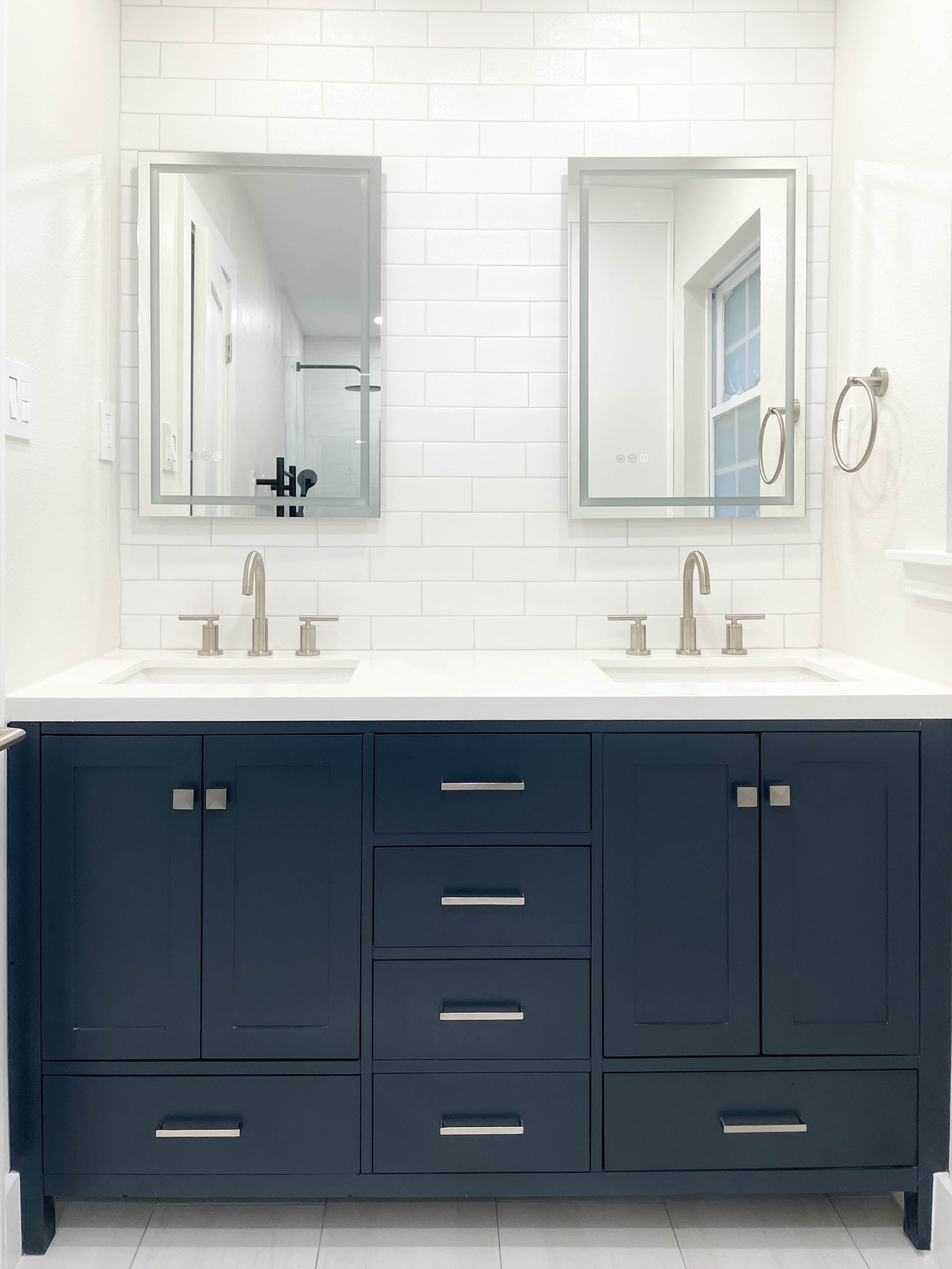When you build your custom home or remodel an existing one, custom cabinetry can be a great option. Going custom gives you cabinets, bookshelves or vanities designed specifically for your unique space and taste. You don’t have to worry about size or material restrictions. You can get creative.
For our custom home builds and remodels, we typically like to work with a custom cabinetry fabricator. Many clients love delving into these details, and they almost always prefer to go custom when it comes to cabinetry in their kitchen and in their primary bathroom and closets, offices, and laundry rooms.
In other rooms, however—those that don’t require many details or tailoring—we suggest going with a pre-made or pre-fabricated option, especially if budget or timing are an issue. This is the case for rooms like guest rooms and playrooms. It also often applies to non-primary bathrooms, including powder rooms and even kids’ bathrooms, where prefabricated, or prefab, vanities can be an excellent choice.
Pre-fabricated vanities are made by a manufacturer ahead of time and they usually come in a selection of standard sizes and in a limited number of materials. When you’re deciding whether to go with a custom or prefab vanity, there are four key factors to keep in mind: space, budget, design and time.
Space. Start by taking a close look at your building or remodel plans and measuring your space to see if going prefab is even an option.
Most prefab vanities come in standard sizes: 24”, 30” and 36”. While recently we’ve started to see more non-standard vanity sizes, such as 32”or 37”, it can still be hard to find a vanity that you like in a non-standard size.
So, if your vanity should sit in between two walls, and you don’t like the idea of having a gap on one or both sides, going with a prefab option might not be possible depending on the size of your room.
When thinking about your space, also make sure you account for the counter top, if it’s included. The counter is typically about half an inch wider than the vanity on either side.
Tip: Check your plumbing location before you buy a floating vanity. With a floating vanity, the drain stub out sits higher than it does with a regular freestanding or built-in vanity. If your plumbing is in the standard position for a regular vanity, it may need to be moved.
Budget. Depending on the quality and brand of vanity you choose, a custom vanity will almost always cost you more than a prefabricated one. Costs add up on custom vanities because several subcontractors often work together to build a custom vanity.
Subcontractors might include a carpenter, painter, finisher, a plumber to install the sink, plumbing fixtures and hardware, and a stone fabricator to cut the countertop. When you buy a prefabricated vanity, the whole vanity comes ready to install with all parts included. Sometimes the vanity will arrive already fully assembled. So, if you’re looking to save money on your project, lean toward prefab.
Design. Sometimes a client might want a certain look for their vanity, but building it custom is prohibitively expensive or too complex. In cases like these in which a design calls for a vintage or a reclaimed look—or even an industrial metal look that will be tough to create with a custom vanity—go for a prefab option.
James Martin Boston
Prefab vanity design tips:
If you’re set on a specific countertop design or a certain sink, you still can go prefab. Purchase a vanity without a countertop and you can have your special counter made that will accommodate the sink you want.
Some vanities come with drawers that are "U" shaped—they have a gap in the center where the drain coming down from the sink passes through. If drawers have a U- shape, we like to use metal drainpipes and p-traps (or ones with a metal look), to match the fixtures and hardware. Since those pieces are partially visible, it’s more pleasing to the eye when opening drawer.
If you have a faucet you like in mind, check the faucet installation type on the prefabricated vanity before you buy it to make sure the two are compatible.
Don’t worry if the prefabricated vanity you like doesn’t have hardware that matches the rest of the bathroom. Mixing metal finishes can add interest to a room. We like to mix: gold/brass with polished nickel, black matte with chrome or brass with chrome with matte black. You can also change out the hardware that comes with the prefabricated vanity since most hardware uses standard fitting dimensions.
Time. If you’re in a time crunch, going prefab will almost always be the better option. Ordering a premade vanity, even building in possible shipping delays, will be faster than custom where materials need to be sourced and purchased (and potentially from a variety of vendors), and the various subcontractors scheduled.
If you do decide to go with a prefabricated vanity, we have several we like that also work well if you’re on a tight budget. Wayfair has a classic-looking wire brushed oak and dark oak prefab vanity, and All Modern has a sleek one that comes in white, walnut or blonde wood. Pottery Barn has two good options as well, including a 36” single sink vanity that comes in four colors, and a 36” to 48” variety that comes in three colors.
Signature Hardware has a nice wall-mount, floating vanity that comes with several countertop material options and a nice one-sink, five-drawer and one cabinet option.
The best design is the one that fits your unique space and personal taste, whether it's custom or prefab, and ultimately brings joy and functionality to your home.















